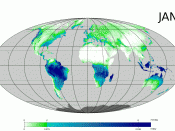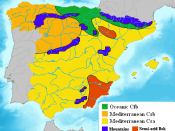Tropical Africa: Food Production and the Inquiry Model
Hunger is the result of disasters such as drought, floods, the
.changing of the jet stream patterns and other natural disasters
.They are beyond our control
It has been estimated that one third of the land in Tropical
Africa is potentially cultivable, though only about 6% of it is
,currently cultivated. However, to change farming from a low-input
low-yield pattern to a high-input, high-yield pattern necessitates
the use of more fertilizer and the planting of high-yielding
.varieties of crops
There are a number of environmental factors, related mostly to
.climate, soils and health, resisting easy developmental solutions
.Rainfall reliability is closely connected to rainfall quantity
The rainfall in the equatorial heart is very plentiful and
reliable. However, there is much less rainfall towards the outer
edges of the rain belt. Periodic and unpredictable droughts are a
.characteristic feature of these border zones
:There are three climatic zones in Tropical Africa
,1.a region of persistent rain at and near the Equator
2.a region on each side of this of summer rain and winter
drought, and
3.a region at the northern and southern edges afflicted by
.drought
All the climates listed in the previous paragraph are modified
in the eastern parts of Tropical Africa by the mountains and
.monsoons
The soils of Tropical Africa pose another problem. They are
unlike the soils of temperate areas. Soils are largely products of
their climates, and tropical soils are different from temperate
soils because the climate is different. Because of the great heat
,of the tropics tends to bake the soils, while on the other hand
the rainfall leaches them. The combined heat and moisture tend to
produce very deep soils because the surface rock is rapidly broken
down by chemical weathering.


